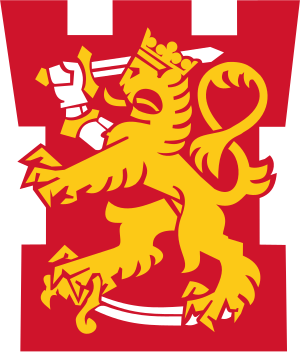Finnish Defense Forces
| Finnish Defence Forces | |
|---|---|

The tower and the lion is the symbol of the Finnish Defence Forces.
|
|
| Current form | 1918 |
| Service branches |
|
| Leadership | |
| President of the Republic | Sauli Niinistö |
| Minister of Defence | Jussi Niinistö |
| Chief of Defence | General Jarmo Lindberg |
| Manpower | |
| Military age | 18 |
| Conscription | 165, 255 or 347 days term |
| Available for military service |
1,155,368 males, age 16–49 (2010 est.), 1,106,193 females, age 16–49 (2010 est.) |
| Fit for military service |
955,151 males, age 16–49 (2010 est.), 912,983 females, age 16–49 (2010 est.) |
| Reaching military age annually |
32,599 males (2010 est.), 31,416 females (2010 est.) |
| Active personnel | 8,086 staff 25,300 conscripts |
| Reserve personnel | 900,000 |
| Deployed personnel | 486 |
| Expenditures | |
| Budget | €2.830 billion; 2017 |
| Percent of GDP | 1.30%; 2017 |
| Industry | |
| Domestic suppliers |
Patria Nammo Robonic SAKO |
| Foreign suppliers |
Former: |
| Annual exports | Volume of about €99 million (2015 est.) |
The Finnish Defence Forces (Finnish: Puolustusvoimat, Swedish: Försvarsmakten) are responsible for the defence of Finland. A universal male conscription is in place, under which all men above 18 years of age serve for 165, 255 or 347 days. Alternative non-military service and volunteer service by women are possible.
Finland is the only non-NATO EU country bordering Russia. Finland's official policy states that a wartime military strength of 230,000 personnel constitutes a sufficient deterrent. The army consists of a highly mobile field army backed up by local defence units. The army defends the national territory and its military strategy employs the use of the heavily forested terrain and numerous lakes to wear down an aggressor, instead of attempting to hold the attacking army on the frontier.
Finland's defence budget equals approximately 2.8 billion euros or 1.3 percent of GDP. The voluntary overseas service is highly popular and troops serve around the world in UN, NATO and EU missions. Homeland defence willingness against a superior enemy is at 76%, one of the highest rates in Europe.
...
Wikipedia
